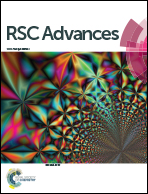Hydrogen titanium oxide hydrate: excellent performance on degradation of methyl blue in aqueous solutions†
Abstract
Nanotube-assembled flower-like hydrogen titanium oxide hydrate (H2Ti2O4(OH)2), which has degradation capacity for methyl blue (MB) even in darkness, was prepared via a microwave solvothermal process. Physicochemical features of the hydrogen titanium oxide hydrate powders were characterized by X-ray diffraction analysis, scanning electron microscopy, transmission electron microscopy, Fourier transform-infrared spectroscopy and UV/VIS/NIR spectrometry. The degradation of methyl blue (MB), methyl orange (MO) and Rhodamine B (Rhb) solution with a water-cooling system was carried out to study the photocatalytic properties of the powders. Results indicate that the H2Ti2O4(OH)2 has excellent performance on degradation of MB, which can be attributed to the hydroxyl group (–OH) from the surface of the catalysts confirmed by electron spin resonance signals (ESR). Furthermore, the intensity of ESR signals rapidly increased with the irradiation time and did not reach maximum after 11 min, which indicated that the photogenerated holes in the valence band of H2Ti2O4(OH)2 catalysts reacted rapidly with surface-bound water or the hydroxyl group and produced a large amount of ˙OH, which was beneficial for degrading MB. The degradation results indicate that these catalysts have potential uses in removing harmful carcinogens from water, in addition to possible applications in reducing the harmful effects of oil spills.


 Please wait while we load your content...
Please wait while we load your content...